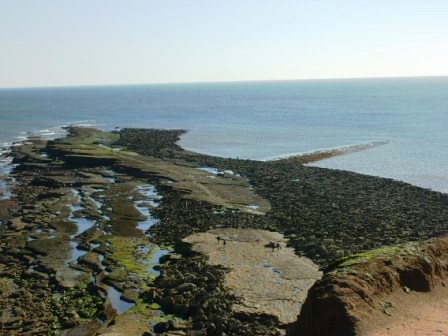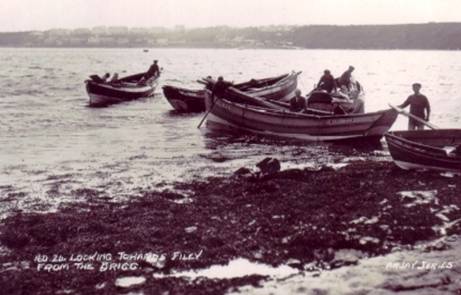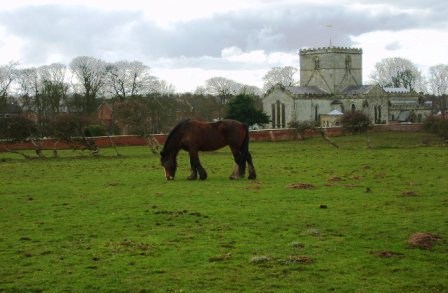
Menu:
'Old Filey'
Filey was a very important fishing station on the Yorkshire Coast with its geographical location as a natural protective harbour. It probably saw commercial fishing activity over a period of hundreds of years. This activity at least for the last 400 years centred around what was King Street and is now Queen Street, and the rows and yards adjoining, which was the heart of ‘Old Filey’ and was home to most of the fishing families.
When we say ‘Old Filey’ what do we really mean?
Filey
had a Roman Signal Station with a garrison of soldiers up on top of
Filey Brigg, this was one of a series of such posts along the
Yorkshire Coast. A most important structure that holds much
speculation still with people is that of the ‘Spittal Rocks’,
located off Filey Brigg. Recent research by the Filey Underwater
Research Group has tended to support the contention that these rocks
form a man-made pier. At very low tides the rocks can be seen to
form a harbour shaped structure with a mouth or opening between two
separate pier structures that may have formed a harbour.

Filey Brigg at a low tide, showing the Spittals bearing out to the right
(Photo - Rodge Dowson 2006)

Filey Cobles, the fishermen are taking visitors of off Filey Brigg, 1930’s?
(Rodge Dowson Collection)
Much fascinating research on this important location has been carried out by the Filey Brigg Research Group, please visit their website for more information on this subject at www.fileybrigg.com.
An archaeological excavation of the site of the development of new housing at the junction of Queen Street and Reynolds Street in 2012 by the York Archaeological Trust also found fragments of pottery of Roman origin. There is also speculation that the original fishing village settlement site was quite possibly located the other side of Church Ravine, the ravine being the natural boundary between the old north and east ridings in the vicinity of the parish church of St. Oswald’s. This area may pre-date the Norman Conquest in the 11th century.

Echoes from other generations, St. Oswald’s Church, upon Carr Naze was this area the location of the earlier settlements at Filey? (Photo – Rodge Dowson 2007)
The Church itself dates from 12th century, the early Norman period, but is much grander than a small fishing village would merit. Later this settlement may have become abandoned at the time of the Black Death in 1347 and the remaining villagers then moved to a new site around what is now Queen Street across the ravine.
Another theory is that there were possibly two separate communities at Filey, as with another major fishing community, Brixham in Devon where there was Cowtown (the older hilltop farming community) and Fishtown, so perhaps the fishing families of Filey have always lived in the Queen Street area.
After the fall of the Roman Empire and the end of their occupation
of
Britain new settlers began arriving. These were at first pirate
raiders from Germany (Angles, Saxons and Jutes). These raiders turned
to settlers and made their homes here amongst the local inhabitants.
It was soon their turn to be under attack from 793 AD onwards, as
Vikings from Scandinavia began to raid and attack up and down the
east coast of Britain. The legacy of Viking settlement can still be
read in place names; for example Gristhorpe, or Fraisthorpe,
“thorpe” originating from the Norse word for village.
Commercial Fishing in the Dark Ages
As with the Saxons before them, the Norse people settled here and established villages of their own and later the town of York fell under Viking rule.
These Viking settlers brought with them excellent skills in boat building and design using the ‘Clinker’ method of overlapping planks or ‘Strangs’ to construct very sea worthy craft. These boats were designed to be launched and beached from coastal locations without harbour structures. Many say that this design and method of construction has added a direct Norse influence to the ‘Yorkshire Coble’ fishing boat.
If we could turn back time it would be wonderful to see what Filey may have looked like in the Roman and Dark Age periods. One perception is that of the Saxon period where a very close community of farmers and fishermen lived together around a manor house with an early church on top of Carr Naze in the area adjoining St. Oswald’s.
Fishing would have been a major source of fresh food if you lived on the coastal fringe and would also provide an important commodity for trade goods by curing or smoking the fish to preserve it to be transported inland or overseas. The importance of herring as a trading commodity was such that it almost replaced money as currency.
Roman and Viking period archaeological sites in York and at other locations have revealed that the communities were supplied with sea fish including cod, which most likely came from the Yorkshire Coast of the north-sea.
Some have suggested that the Vikings may have taught their fishing skills to the natives of the Yorkshire Coastal settlements as from around this time onward commercial fishing became the main source of national wealth after the wool sales.
Further information about the long term impact of fishing on the ecology of the North Sea can be found here.